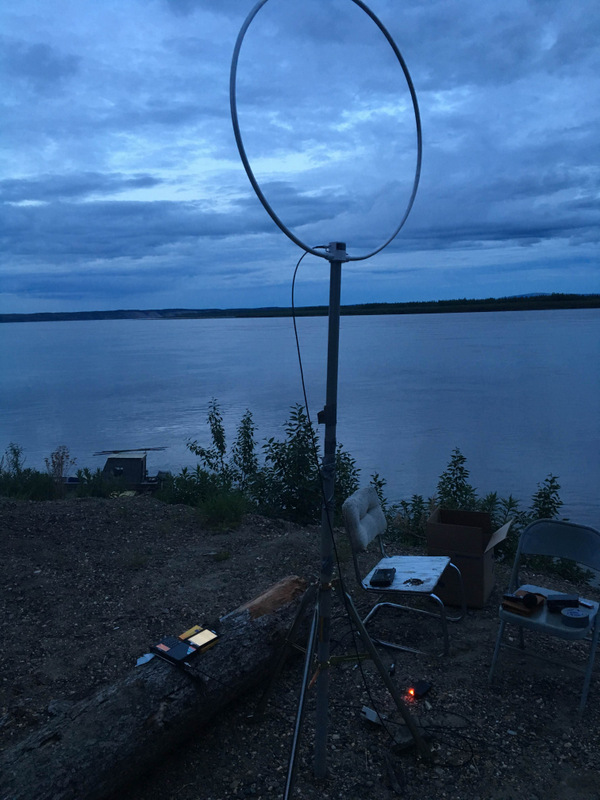Many thanks to SWLing Post contributor, Pete Jernakoff, who writes:
[…]I’m hopeful that one of your readers might be able to suggest a solution to my problem.
I have an older Wellbrook Communications active loop antenna that is powered by a 12 v AC-to-DC, center pin negative, plug-in power supply (Stancor AC Adapter, was supplied with the antenna).
I’d like to power the antenna from a rechargeable battery in order to make the antenna portable and to eliminate any noise that might be emanating from said power supply (which, as an aside, runs very warm when in operation).
My problem is that I cannot find any rechargeable batteries (lithium ion preferred) with a center pin negative output. All of the ones that I can find online have center pin positive outputs (such as the TalentCell 12V/6000mAh rechargeable battery that I’ve purchased to power my other, more recently produced, Wellbrook Communications active loop antenna whose amp needs a center pin *positive* input).
Thanks in advance for consideration of my request. Btw, love your blog! I’ve been an avid reader of it for quite some time now.
Post readers: If you have any suggestions for Pete, please comment with any relevant links to help him make the purchase. I’m guessing Pete isn’t interested in re-soldering a coaxial plug for negative tip polarity at this point.
By the way, I used a photo of Paul Walker’s Wellbrook at the top of this post because I recall that when he lived in Alaska, he powered his Wellbrook loop with a rechargeable pack (and during the winter, I also recall he struggled to keep it warm enough to provide power for any length of time!). Perhaps Paul can comment.
I’m so glad you enjoy the SWLing Post, Pete!


Something like this might help, 2.1mm CCTV 2-wire lead adapter + CCTV power plug. Take the wire from your battery and plug it into a power wire lead adapter that has wires at the other end:
https://www.ebay.com/itm/DC-3ft-Male-2-Wire-Lead-Jack-Plug-Power-Cable-Connectors-2Pcs-5-5-x-2-1mm/262682448264
Then, stick those two wires into this adapter with reverse polarity:
https://www.ebay.com/itm/2-1mm-DC-Power-Plug-Male-for-SECURITY-CAMERAS-Terminal-Block-adapter-connector/120865836157
Make sure you test the polarity with a volt meter before you plug it into the older Wellbrook module or you could short it out. (To test, always put the positive Red probe into the tip center and the negative Black probe on the outside of the tip and the meter should read Negative 12V if you wired it correctly!).
I always wrap one turn of excess wire around the outside of the square part of the adapter body (the wires can break easily with any use!) and carefully superglue the wire jacket to the adapter body being careful not to get any glue onto the terminals. I have a few AA and a large 20Ah battery connected this way and is very convenient. If I need a different adapter, I just create a new one since they are so cheap, you can get 10 for $5 and no soldering needed. 🙂
Thanks to all who commented! The suggestion to simply make a cable that reverses the polarities is so obvious that I’m annoyed that I didn’t think of it myself. Easy enough to do. However, eBay to the rescue: just purchased several inexpensive, polarity reversing, pre-made cables that were available for sale. Rgds, -Pete-
Like another another person that replied said cut the wires going to the plug and swap them.First mark them well with a marking pen in a contrasting color like silver or red and white tape,then cut them.Solder or use small wire nuts,tape them and your done.
They’re not uncommon; almost every pro musician/sound guy I know has a handful, because most effects pedals and the like are centre-negative (except for the ones that aren’t!).
Google “reverse polarity converter” or “polarity inverter cable” and you’ll find them everywhere from Aliexpress to DJ & pro music stores. Sometimes they’re branded/labelled for a particular PSU (e.g. “Truetone 1 Spot Reverse Polarity Converter”), but there’s nothing special about them. Just make sure you’ve got the right plug size for your equipment.
You don’t want to mess up the connector on the battery since that will be needed for the charger.
I’d suggest buying a DC Power Male to Female Adapter Extension Cable. You would then cut this cable in the middle and switch the wires. Now you have a plug with center negative at one end and center positive at the other end.
Make sure you get one with the correct size connectors,
i.e. Inside diameter 2.1mm; Outer diameter 5.5mm,
or whatever size you need.
Be careful that you don’t accidentally hook the charger up to the extension cable. I would suggest
plugging the modified extension cable into the Wellbrook antenna and then taping it so it can’t easily
be removed. Then Plug/unplug the battery from the modified cable as required for charging.
73
Bill (Smithville, NJ)
WD9EQD
Seconded ! That would be the easiest approach, pick the cable, some heathshrink tubing and some insulating tape, cut the wire, insert the tubing on one end, strip the insulator and reverse the connections, wrap each wire with the tape, slite the tubing over and heat it to shrink, wrap the connection with tape, done 🙂
Find an 8 D alkaline battery holder from superbrightleds.com for $4 per. I buy a few at a time…. get some rechargeable batteries…. there you go! It’s what I do, and what I’ve done for 3-4 years
I’ve done the same with 2, 4, 6, and 8 D cell holders using brass machine screws as screw post. Attach the power wiring in what ever polarity you need. Part of my standard bad weather kit.
Why don’t you build a simple male/female adapter, it would just take two connectors, a piece of wire and little more